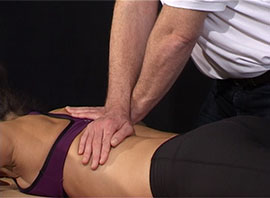The McKenzie Method
The McKenzie Method® - an overview
The McKenzie Method® of Mechanical Diagnosis and Therapy® (MDT) is a biopsychosocial system of MSK assessment and care emphasizing patient empowerment and self-management. It is an evidence-based system that can be applied to acute, subacute and chronic conditions of the spine and the extremities. 1-5
It offers a reliable6,7,8 and practical approach that puts the patient’s needs first and guides the clinician in meeting those needs.
The McKenzie assessment enables clinicians to triage patients accurately and efficiently to the appropriate services required. It allows the early identification of red flags which may indicate the presence of Serious Pathology, where immediate referral onwards is necessary.9 Research has shown that a significant proportion of patients with non-serious spinal and extremity pain respond well to specific exercises and experience fewer symptoms when treated with exercises individualised to the patient.10,11
The unique combination of postural advice and the application of specific individualised exercises when delivered by an McKenzie trained clinician enable the majority of patients to effectively self-manage their condition. This process promotes patient empowerment, increases satisfaction with treatment and is cost-effective.12,13
References:
- McKenzie and May 2000, 2003, 2006
- Clare et al. 2004
- May and Donelson 2008
- Dunsford et al. 2011
- Rosedale et al. 2014
- Kilpikoski et al. 2002
- Heider Abady et al. 2014
- Willis et al. 2016
- Chaniotis 2012
- Long et al. 2004
- Albert and Manniche 2012
- Manca et al. 2007
- Deutscher et al. 2014
Robin McKenzie on MDT
The Method - Step by step guide

ASSESSMENT

The McKenzie System uses a validated assessment process which enables the clinician to categorise the patient into distinct classifications. These well-defined classifications guide the appropriate management strategy.
An important component of the assessment is that the clinicians who are well trained in the McKenzie System are able to recognise patients with pathologies unsuitable for therapy. These patients can be immediately referred for further medical evaluation to the appropriate specialist.
After careful questioning about how the symptoms are impacting or limiting the patient, and how different movements and positions affect the symptoms, the patient is asked to move in various directions and tell the clinician the effect of these various movements. For spinal patients, rapid changes occur in 50-70% of cases (depending on how long they have had their symptoms). Pain can move from a distal to a more proximal location in response to directionally specific movements. If the appropriate movement is continued, the pain retreats towards the spine. This phenomenon is called Centralisation and many peer review studies have shown that patients whose symptoms centralise have a better outcome than the non-centralisers1 2
Accompanying centralisation is a gradual increase in range of movement. This phenomenon occurs in a subgroup of patients experiencing spinal pain.
References:
- Werneke et al, 1999, 2005, 2008
- May and Aina 2012

CLASSIFICATION
Based on the interpretation of findings from the assessment, McKenzie trained clinicians will classify patient presentations into one of the 16 mutually exclusive classifications. All these classifications have clear-cut clinical operational definitions to allow identification in daily clinic.
The unique nature and presentation of each classification plus consideration of individual patient factors guides management and treatment. Specific exercises, repeated movements, sustained posture and education on the behaviour of symptoms are vital components of most interventions.

TREATMENT
Once the patient has been classified, McKenzie trained clinicians work in collaboration with the patient to initiate a management plan that is specific to the determined classification and that takes into account the patient’s individual needs and considerations for return to optimum function.
Below are some examples:
If the classification is Derangement Syndrome the patient would be given an exercise that moves them into their Directional Preference.
If the classification is Contractile Dysfunction the patient would be guided to load the tissue in a graduated way to stimulate recovery.
If the classification is Chronic Pain Syndrome the patient would be guided through an individualised, graded, progressive and paced plan to regain confidence in movement for greater function.
All patients would be involved in a discussion regarding the nature of their problem and their role in self-management.
The McKenzie System emphasises self-management and patient independence. For this reason, patient generated forces are used as a first resource. Only where these forces are insufficient, are they supplemented by clinician procedures, such as mobilisation.

Prevention
The McKenzie System seeks to equip patients with the appropriate strategies beyond short term relief for prevention of recurrence. Research has shown that spinal pain in particular has a tendency to recur and recurrences often occur with increasing severity. Preventing recurrence is therefore more important than supplying short term relief through passive treatment.
"It (The McKenzie System) does effectively teach patients to self-manage well enough so that they do not need to seek care from a healthcare practitioner when LBP recurs." de Campos et al 2020